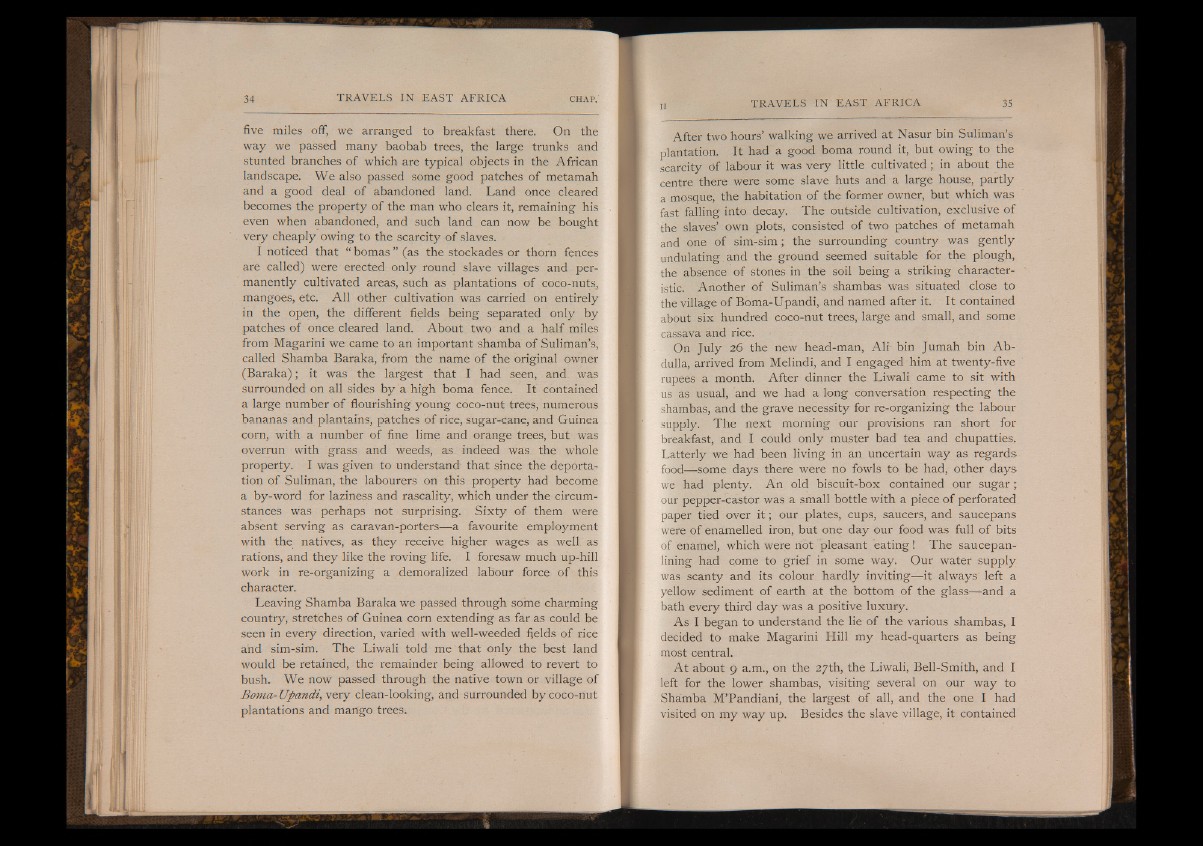
five miles off, we arranged to breakfast there. On the
way we passed many baobab trees, the large trunks and
stunted branches of which are typical objects in the African
landscape. We also passed some good patches of metamah
and a good deal of abandoned land. Land once cleared
becomes the property of the man who clears it, remaining his
even when abandoned, and such land can now be bought
very cheaply owing to the scarcity of slaves.
I noticed that “ bomas 1 (as the stockades or thorn fences
are called) were erected only round slave villages and permanently
cultivated areas, such as plantations of coco-nuts,
mangoes, etc. All other cultivation was carried on entirely
in the open, the different fields being separated only by
patches of once cleared land. About two and a half miles
from Magarini we came to an important shamba of Suliman’s,
called Shamba Baraka, from the name of the original owner
(Baraka); it was the largest that I had seen, and. was
surrounded on all sides by a high boma fence. It contained
a large number of flourishing young coco-nut trees, numerous
bananas and plantains, patches of rice, sugar-cane, and Guinea
corn, with a number of fine lime and orange trees, but was
overrun with grass and weeds, as. indeed was the whole
property. I was given to understand that since the deportation
of Suliman, the labourers on this property had become
a by-word for laziness and rascality, which under the circumstances
was perhaps not surprising. Sixty of them were
absent serving as caravan-porters— a favourite employment
with the natives, as they receive higher wages as well as
rations, and they like the roving life. I foresaw much up-hill
work in re-organizing a demoralized labour force of this
character.
Leaving Shamba Baraka we passed through some charming
country, stretches of Guinea corn extending as far as could be
seen in every direction, varied with well-weeded fields of rice
and sim-sim. The Liwali told me that only the best land
would be retained, the remainder being allowed to revert to
bush. We now passed through the native town or village of
Boma- Upandi, very clean-looking, and surrounded by coco-nut
plantations and mango trees.
After two hours’ walking we arrived at Nasur bin Suliman’s
plantation. It had a good boma round it, but owing to the
scarcity Of labour it was very little cultivated; in about the
centre there were some slave huts and a large house, partly
a mosque, the habitation of the former owner, but which was
fast falling into decay. The outside cultivation, exclusive of
the slaves’ own plots, consisted of two patches of metamah
and one of sim-sim; the surrounding country was gently
undulating and the ground seemed suitable for the plough,
the absence of stones in the soil being a striking characteristic.
Another of Suliman’s shambas was situated close to
the village of Boma-Upandi, and named after it. It contained
about six hundred coco-nut trees, large and small, and some
cassava and rice.
On July 26 the new head-man, Ali bin Jumah bin Ab dulla,
arrived from Melindi, and I engaged him at twenty-five
rupees a month. After dinner the Liwali came to sit with
us as usual, and we had a long conversation respecting the
shambas, and the grave necessity for re-organizing the labour
supply. The next morning our provisions ran short for
breakfast, and I could only mu.ster bad tea and chupatties.
Latterly we had been living in an uncertain way as regards
food— some days there were no fowls to be had, other days
we had plenty. An old biscuit-box contained our sugar;
our pepper-castor was a small bottle with a piece of perforated
paper tied over i t ; our plates, cups, saucers, and saucepans
were of enamelled iron, but one day our food was full of bits
of enamel, which were not pleasant eating! The saucepan-
lining had come to grief in some way. Our water supply
was scanty and its colour hardly inviting— it always left a
yellow sediment of earth at the bottom of the glass— and a
bath every third day was a positive luxury.
As I began to understand the lie of the various shambas, I
decided to make Magarini Hill my head-quarters as being
most central.
A t about 9 a.m., on the 27th, the Liwali, Bell-Smith, and I
left for the lower shambas, visiting several on our way to
Shamba M’Pandiani, the largest of all, and the one I had
visited on my way up. Besides the slave village, it contained